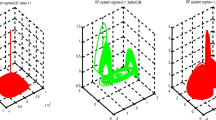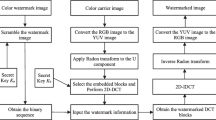Abstract
Self-embedding fragile watermarking algorithms can perform detection of the manipulated areas as well as recovery of these detected areas. Most of the self-embedding fragile watermarking algorithms are performed block-wise authentication approach. However, entire block is marked as tampered in case one of the pixels in the block is detected as manipulated. This situation decreases the accuracy rate of the authentication process especially against pixel-based attacks such as salt and paper noise adding. Therefore, we present a novel pixel-wise authentication-based self-embedding fragile watermarking method for manipulation detection and recovery. In this proposed method, reference image is divided into four main blocks. Then, each main block is subdivided into \(2\times 4\) or \(4\times 2\) sized blocks according to block type determined using recovery quality. Recovery bits of each main block generated from sub-blocks are spreaded into the two main blocks in the other half of the image. For each pixel, two authentication bits are generated using the six most significant bits of the pixel with two pixel position bits and then embedded into the first and second least significant bits of the pixel. In experimental results, pixel-based attacks are applied to the images to demonstrate the success of the presented method. Also, performance of the presented method has been evaluated by applying different size of cropping attacks to the watermarked images. Experimental results show that the proposed method satisfactory detect and recover the manipulated areas.


















Similar content being viewed by others
References
Ansari, I.A., Pant, M., Ahn, C.W.: Svd based fragile watermarking scheme for tamper localization and self-recovery. Int. J. Mach. Learn. Cybernet. 7(6), 1225–1239 (2016)
Bravo-Solorio, S., Calderon, F., Li, C.T., Nandi, A.K.: Fast fragile watermark embedding and iterative mechanism with high self-restoration performance. Digital Sig. Process. 73, 83–92 (2018)
Cao, F., An, B., Wang, J., Ye, D., Wang, H.: Hierarchical recovery for tampered images based on watermark self-embedding. Displays 46, 52–60 (2017)
Chen, W.C., Wang, M.S.: A fuzzy c-means clustering-based fragile watermarking scheme for image authentication. Expert Systems with Applications 36(2, Part 1):1300 – 1307 (2009)
Chuang, J.C., Hu, Y.C.: An adaptive image authentication scheme for vector quantization compressed image. J. Vis. Commun. Image Represent. 22(5), 440–449 (2011)
Chun-Shien, Lu, Liao, H.M.: Structural digital signature for image authentication: an incidental distortion resistant scheme. IEEE Trans. Multimedia 5(2), 161–173 (2003)
Gul, E., Ozturk, S.: A novel hash function based fragile watermarking method for image integrity. Multimedia Tools Appl. 78(13), 17701–17718 (2019)
Huang, R., Liu, H., Liao, X., Sun, S.: A divide-and-conquer fragile self-embedding watermarking with adaptive payload. Multimedia Tools Appl. 78(18), 26701–26727 (2019)
Kim, C., Shin, D., Yang, C.N.: Self-embedding fragile watermarking scheme to restoration of a tampered image using ambtc. Personal Ubiquitous Comput. 22(1), 11–22 (2018)
Lee, C.F., Shen, J.J., Chen, Z.R., Agrawal, S.: Self-embedding authentication watermarking with effective tampered location detection and high-quality image recovery. Sensors 19(10), 2267 (2019)
Lee, T.Y., Lin, S.D.: Dual watermark for image tamper detection and recovery. Pattern Recognit. 41(11), 3497–3506 (2008)
Lin, P., Lee, J., Chang, C.: Dual digital watermarking for internet media based on hybrid strategies. IEEE Trans. Circuits Syst. Video Technol. 19(8), 1169–1177 (2009)
Lin, P.L., Hsieh, C.K., Huang, P.W.: A hierarchical digital watermarking method for image tamper detection and recovery. Pattern Recognit. 38(12), 2519–2529 (2005)
Martino, F.D., Sessa, S.: Fragile watermarking tamper detection with images compressed by fuzzy transform. Inform. Sci. 195, 62–90 (2012)
Puhan, N.B., Ho, A.T.: Secure authentication watermarking for localization against the holliman-memon attack. Multimedia Syst. 12(6), 521–532 (2007)
Qian, Z., Feng, G., Zhang, X., Wang, S.: Image self-embedding with high-quality restoration capability. Digital Signal Process. 21(2), 278–286 (2011)
Qin, C., Ji, P., Zhang, X., Dong, J., Wang, J.: Fragile image watermarking with pixel-wise recovery based on overlapping embedding strategy. Signal Process. 138, 280–293 (2017)
Rajkumar, R., Vasuki, A.: Reversible and robust image watermarking based on histogram shifting. Cluster Comput. 22(5), 12313–12323 (2019)
Rayachoti, E., Tirumalasetty, S., Prathipati, S.C.: Slt based watermarking system for secure telemedicine. Cluster Computing pp 1–10 (2020)
Rhayma, H., Makhloufi, A., Hamam, H., Hamida, A.B.: Semi-fragile self-recovery watermarking scheme based on data representation through combination. Multimedia Tools Appl. 78(10), 14067–14089 (2019)
Shehab, A., Elhoseny, M., Muhammad, K., Sangaiah, A.K., Yang, P., Huang, H., Hou, G.: Secure and robust fragile watermarking scheme for medical images. IEEE Access 6, 10269–10278 (2018)
Singh, D., Singh, S.K.: Effective self-embedding watermarking scheme for image tampered detection and localization with recovery capability. J. Vis. Commun. Image Represent. 38, 775–789 (2016)
Singh, P., Agarwal, S.: An efficient fragile watermarking scheme with multilevel tamper detection and recovery based on dynamic domain selection. Multimedia Tools Appl. 75(14), 8165–8194 (2016)
Sreenivas, K., Kamakshiprasad, V.: Improved image tamper localisation using chaotic maps and self-recovery. J Vis Commun. Image Represent. 49, 164–176 (2017)
Tai, W.L., Liao, Z.J.: Image self-recovery with watermark self-embedding. Signal Process. 65, 11–25 (2018)
Thanh, T.M., Iwakiri, M.: Fragile watermarking with permutation code for content-leakage in digital rights management system. Multimedia Syst. 22(5), 603–615 (2016)
Tsai, P., Hu, Y.C., Chang, C.C.: Novel image authentication scheme based on quadtree segmentation. Imaging Sci. J. 53(3), 149–162 (2005)
Wang Z: Image quality assessment: from error visibility to structural similarity. IEEE Trans. Image Process. 13(4), 600–612 (2004)
Xie, X., Wang, C., Li, M.: A fragile watermark scheme for image recovery based on singular value decomposition, edge detection and median filter. Appl. Sci. 9(15), 3020 (2019)
Yan, C., Gong, B., Wei, Y., Gao, Y.: Deep multi-view enhancement hashing for image retrieval. IEEE Transactions on Pattern Analysis and Machine Intelligence (2020a)
Yan, C., Li, Z., Zhang, Y., Liu, Y., Ji, X., Zhang, Y.: Depth image denoising using nuclear norm and learning graph model. arXiv preprint (2020b) arXiv:200803741
Yan, C., Shao, B., Zhao, H., Ning, R., Zhang, Y., Xu, F.: 3d room layout estimation from a single rgb image. IEEE Transactions on Multimedia (2020c)
Yang, S., Qin, C., Qian, Z., Xu, B.: Tampering detection and content recovery for digital images using halftone mechanism. In: 2014 tenth International conference on intelligent information hiding and multimedia signal processing, pp 130–133 (2014)
Zhang, X., Wang, S.: Statistical fragile watermarking capable of locating individual tampered pixels. IEEE Signal Process. Lett. 14(10), 727–730 (2007)
Author information
Authors and Affiliations
Corresponding author
Additional information
Communicated by L. Zhou.
Publisher's Note
Springer Nature remains neutral with regard to jurisdictional claims in published maps and institutional affiliations.
Rights and permissions
About this article
Cite this article
Gul, E., Ozturk, S. A novel pixel-wise authentication-based self-embedding fragile watermarking method. Multimedia Systems 27, 531–545 (2021). https://doi.org/10.1007/s00530-021-00751-3
Received:
Accepted:
Published:
Issue Date:
DOI: https://doi.org/10.1007/s00530-021-00751-3




